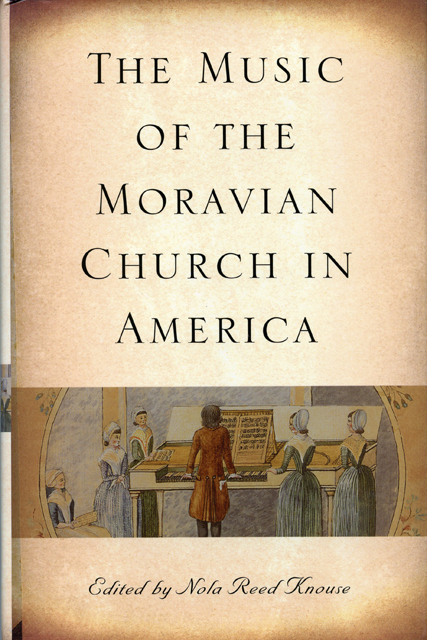Book contents
- Frontmatter
- Contents
- List of Illustrations
- Foreword
- Preface
- Acknowledgments
- 1 The Moravians and Their Music
- 2 Moravian Worship: The Why of Moravian Music
- 3 Hymnody of the Moravian Church
- 4 Moravian Sacred Vocal Music
- 5 The Organ in Moravian Church Music
- 6 The Role and Development of Brass Music in the Moravian Church
- 7 The Collegia Musica: Music of the Community
- 8 Music in Moravian Boarding Schools through the Early Nineteenth Century
- 9 The Piano among the Moravians in the Eighteenth and Nineteenth Centuries: Music, Instruction, and Construction
- 10 Moravian Music: Questions of Identity and Purpose
- Appendix 1 Biographical Sketches
- Appendix 2 A Moravian Musical Timeline
- Bibliography
- List of Contributors
- Index
- Eastman Studies in Music
2 - Moravian Worship: The Why of Moravian Music
Published online by Cambridge University Press: 10 March 2023
- Frontmatter
- Contents
- List of Illustrations
- Foreword
- Preface
- Acknowledgments
- 1 The Moravians and Their Music
- 2 Moravian Worship: The Why of Moravian Music
- 3 Hymnody of the Moravian Church
- 4 Moravian Sacred Vocal Music
- 5 The Organ in Moravian Church Music
- 6 The Role and Development of Brass Music in the Moravian Church
- 7 The Collegia Musica: Music of the Community
- 8 Music in Moravian Boarding Schools through the Early Nineteenth Century
- 9 The Piano among the Moravians in the Eighteenth and Nineteenth Centuries: Music, Instruction, and Construction
- 10 Moravian Music: Questions of Identity and Purpose
- Appendix 1 Biographical Sketches
- Appendix 2 A Moravian Musical Timeline
- Bibliography
- List of Contributors
- Index
- Eastman Studies in Music
Summary
Those who have studied the music of eighteenth- and early nineteenth-century Moravian composers have been impressed with the skill and artistry of many of them. As with anything else, however, the full explication and appreciation of their music and gifts requires some knowledge and understanding of the context, the matrix, within which they wrote, and for Moravian composers that necessarily leads to a consideration of Moravian worship.
A musicologist who knows nothing of the Moravian Church or of its theology and life in the eighteenth century can, of course, analyze and certainly appreciate Moravian music. In reality, though, that approach is similar to observing a prehistoric honeybee preserved in a block of amber. The carcass of the bee is there to behold, and one can provide a description, even a minute analysis, of the bee: its size, wingspread, coloration, and all the rest. This can give only the vaguest idea of the essence of the bee, however. It cannot begin to fathom the full life of the bee: the meadows in which it lived, its relation to its fellow bees, the beauty of its soaring flight in a fleeting dawn millennia ago.
Of course, the case of this music is not exactly like that of the bee in amber. We are not restricted merely to a fossilized determining of the most frequent key signatures and characteristic harmonizations. We are fortunate to be able to get more than a lifeless appreciation of Moravian music simply by playing it or hearing it played. That is certainly an advance over the petrified insect, though even this is still somewhat like thinking we one may know all about a prehistoric bee by seeing a live one buzzing around in a cage. It still is not the same as experiencing reality with the bee in its natural habitat.
- Type
- Chapter
- Information
- The Music of the Moravian Church in America , pp. 29 - 43Publisher: Boydell & BrewerPrint publication year: 2009
- 1
- Cited by



